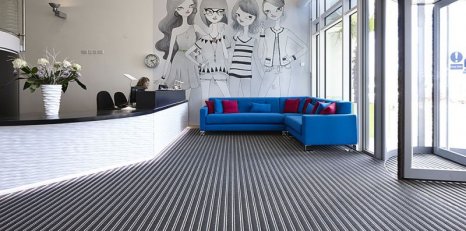The pandemic has meant that, for many education buildings, the usual routines of refurbishment have been disrupted. With many schools, colleges and universities having only reopened fully this month, priorities have understandably been on other things than maintenance – not least ensuring that any teaching could go on at all.
As near-normal service resumes, however, the time has come for education facility managers to refocus their attention on ensuring their buildings are providing the best possible learning environment for returning students. Here is an overview of some of the best interior solutions that will help you achieve this.
1. Barrier matting
One thing most education buildings have in common is the high amount of footfall they experience throughout the average day. This constant flow of students, teachers and other staff brings a huge amount of dirt and moisture into the building from outside – slowly soiling the internal floorcoverings and potentially creating slip hazards where water is allowed to gather on hard floors.
This makes the right type of barrier matting essential. Appropriate matting will scrape and absorb the dirt and moisture from people’s shoes as they enter your building, intercepting them before they can damage carpets. In this way it will create a safer environment while ensuring that the aesthetic design of the interior is not compromised.
An ideal solution for most educational buildings is our Esplanade 5000. Constructed from a choice of ECONYL® regenerated solution dyed nylon wipers or black PVC scraper wipers, Esplanade 5000 offers excellent soil and moisture retention to keep your building protected and is available in a choice of nine colours to suit any design scheme.
Don’t forget that barrier matting should also be installed in internal areas that are vulnerable to soiling or heavy wear, such as receptions, canteens, main corridors and staircases. Working in tandem with Esplanade 5000, our Boulevard 5000 is a secondary barrier matting solution that incorporates a light scraper for dirt removal and features a heathered design to disguise the effects of soiling.
2. Wall cladding
Just as heavy foot traffic brings in contaminants from outside, so it damages the walls within your building. This is particularly true in busy corridors between periods, where students carrying bags will routinely brush against the walls as they pass, causing scuffs and scrapes that bring down the aesthetics of the environment and can also harbour bacteria.
As a result, wall cladding is essential to any education building. When installed in the right areas, wall cladding will protect vulnerable corridor walls against the everyday onslaught of students – saving you a significant amount on maintenance in the long term as the endless cycle of re-painting comes to an end.
For high-traffic areas, look out for textured and through-coloured solutions, as these will conceal the effects of any damage inflicted upon them, preserving the neat appearance of the corridor or classroom. An example is our SureProtect® Endure, which provides an especially durable and protective layer in a wide selection of colours to suit any environment.
Increasingly popular are solutions that provide an element of visual style, helping to create a more engaging and inspiring learning environment. Our SureProtect® Design, for example, offers a range of finishes in woods and metals, as well as the option to create bespoke designs, which could be specially commissioned artworks or pictures by students.
3. Stair edgings & floor trims
While stair edgings can seem like minor details, everyday wear and other factors such as intensive cleaning regimes can result in them becoming less effective over time. It is therefore critical that the correct profile option is selected at the very outset to create a safer environment which in turn helps to reduce trip hazards or the potential for legal challenges if an accident did occur. Our quick and easy ‘3 step guide to selecting the correct stair edging’ highlights all the key considerations and can be found within our new Stair Edgings & Floor Trims brochure – download a copy here.
The Gradus XT range of stair edgings offer the ultimate solution in reducing slips, trips and falls on stairs and has been developed in line with the latest legislation and guidelines such as Approved Document M (ADM) of The Building Regulations 2010, BS 8300-2:2018 and research from BRE (Building Research Establishment). It is recommended that there should be at least a 30 points difference between the LRV (light reflectance value) of the stair edgings and floorcovering to achieve a suitable contrast.
Our XT range is available with either aluminium or PVC-u channels and come with a choice of slip-resistant inserts that extend around the leading edge of the stair edgings, ensuring that foot contact is always made with the slip-resistant element of the stair edging. The inserts also feature a unique locking mechanism that secures the insert in place without the need for adhesive, making these an ideal choice for areas where more intensive cleaning is required such as within healthcare or education applications.
In addition, make sure to check whether any of the floor trims throughout your building need replacing. If they have become loose or broken from too much foot traffic, they are likely to pose a trip hazard, not to mention the scruffy impression that this makes. We offer a wide range of floor trims that can either be chosen to blend in with the surrounding floorcoverings or act as a highlight to help denote walkways and other circulation areas.



